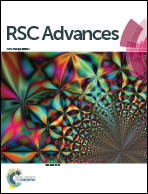Copper-catalyzed carbonylative Suzuki coupling of aryl iodides with arylboronic acids under ambient pressure of carbon monoxide†
Abstract
An efficient and ligandless nanocopper-catalyzed carbonylative cross-coupling of aryl iodides with arylboronic acids at ambient CO pressure in poly(ethylene glycol), has been developed. This protocol is general, practical, and recyclable, and offers an attractive alternative to the corresponding palladium-mediated carbonylative Suzuki process for the construction of biaryl ketone scaffolds.


 Please wait while we load your content...
Please wait while we load your content...